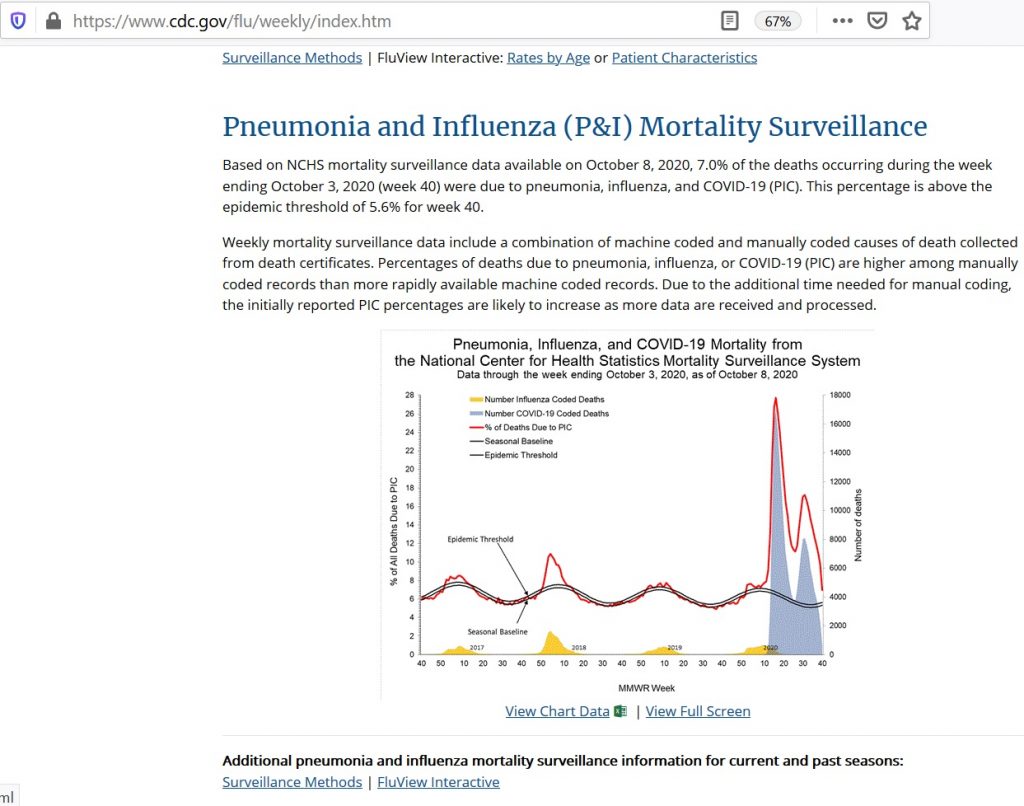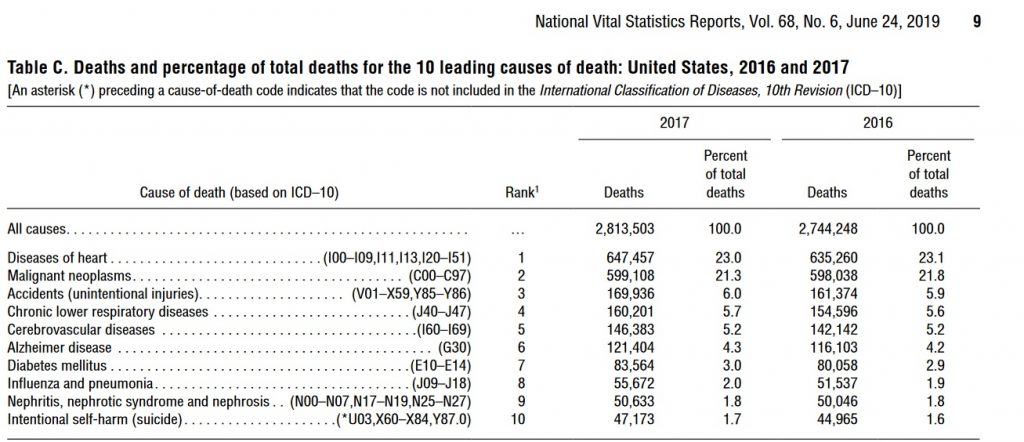A short video showing the contradictory pneumonia and influenza death numbers on the CDC web site and official documents. The FluView web site claims six to ten percent of all deaths are due to pneumonia and influenza in a prominently displayed graphic. However, the Leading Causes of Death report claims about two percent of deaths are caused by pneumonia and influenza, less than one third of the percentages reported on the FluView web site. Detailed references are provided below.
Looking at the numbers behind the percentages. The CDC uses two grossly contradictory numbers of annual deaths from pneumonia and influenza: about 55,000 in the annual leading causes of the death report and about 188,000 in National Center for Health Statistics (NCHS) data used on the FluView web site to report the percentage of deaths each week due to pneumonia and influenza. These differ by a factor of OVER THREE. The larger FluView number is comparable to the current cumulative total COVID-19 deaths in the United States.
The most recent raw data appears to still be accessible on the FluView Pneumonia and Influenza Mortality web page:
https://www.cdc.gov/flu/weekly/index.htm (see Pneumonia and Influenza Mortality Section)

FluView NCHS Raw Data File: https://www.cdc.gov/flu/weekly/weeklyarchives2019-2020/data/NCHSData34.csv
Leading Causes of Death Full Report: https://www.cdc.gov/nchs/data/nvsr/nvsr68/nvsr68_06-508.pdf
See Table C: Deaths and percentage of total deaths for the 10 leading causes of death: United States, 2016 and 2017 (Page 9 of PDF)
Line item 8 “Influenza and pneumonia” lists 55,672 deaths in 2017

The most likely reason for the gross discrepancy between the FluView percentages and death numbers and the leading causes of death is that the FluView graphic counts any death certificate with pneumonia or influenza listed as “a cause of death.” Death certificates often list multiple causes of death. The leading causes of death report appears to list only death certificates that list pneumonia or influenza as the “underlying cause of death,” which may be a rather arbitrary assignment of causation to a single cause of death. While the fine print seems to say this, it is ambiguous.
Consequentially, the CDC death numbers can vary enormously depending on the definition of cause of death — or some other reason that is not clearly documented in the CDC documents. This is discussed further in the associated video.
A significant question is what fraction of the numbers, especially on the FluView web site, are due to opportunistic infections where the immune system or general health is so weakened by some other cause such as chemotherapy, AIDS, cancer, the aging process etc. that death is likely or inevitable and multiple infections may be present. The likely purpose of the FluView graphic and numbers is to frighten the public into purchasing the flu vaccine — which is unlikely to work for patients whose immune system weakens or fails.
Peter Doshi’s Critiques of US Flu Death Numbers
Are US flu death figures more PR than science? British Medical Journal (2005)
https://www.bmj.com/content/331/7529/1412
Influenza : a study of contemporary medical politics Ph.D. Dissertation, MIT (2011)
https://dspace.mit.edu/handle/1721.1/69811
Influenza: marketing vaccine by marketing disease, British Medical Journal (2013)
https://www.bmj.com/content/346/bmj.f3037
References on the Influenza Vaccine
https://www.scientificamerican.com/article/flu-shots-may-not-protect-the-elderly-or-the-very-young/
https://jamanetwork.com/journals/jamainternalmedicine/fullarticle/486407
February 14, 2005
Impact of Influenza Vaccination on Seasonal Mortality in the US Elderly Population
Lone Simonsen, PhD; Thomas A. Reichert, MD, PhD; Cecile Viboud, PhD; et al William C. Blackwelder, PhD; Robert J. Taylor, PhD; Mark A. Miller, MD
Arch Intern Med. 2005;165(3):265-272. doi:10.1001/archinte.165.3.265
https://www.thelancet.com/journals/laninf/article/PIIS1473-3099(11)70295-X/fulltext
The Lancet Infectious Diseases
Articles| Volume 12, ISSUE 1, P36-44, January 01, 2012
Efficacy and effectiveness of influenza vaccines: a systematic review and meta-analysis
Prof Michael T Osterholm, PhD
Nicholas S Kelley, PhD
Prof Alfred Sommer, MD
Edward A Belongia, MDPublished:October 26, 2011DOI: https://doi.org/10.1016/S1473-3099(11)70295-X
Avoid Censorship
Avoid Internet Censorship by Subscribing to Our RSS News Feed: http://wordpress.jmcgowan.com/wp/feed/
Legal Disclaimers: http://wordpress.jmcgowan.com/wp/legal/
Support Us:
PATREON: https://www.patreon.com/mathsoft
SubscribeStar: https://www.subscribestar.com/mathsoft
Subscribers gain access to the advanced professional features of our censored search web site and service — https://censored-search.com — a search engine for censored Internet content banned or shadow-banned by increasingly censored, advertising beholden social media and search engines such as Google, YouTube, and Facebook. The free version of censored-search.com — available to all — uses a modified page rank algorithm, essentially a popularity contest. The paid professional version includes advanced search algorithms to find and prioritize content that is probably being censored by vested interests because it is useful and true — for example, evidence that a product or service is harmful to users.
BitChute (Video): https://www.bitchute.com/channel/HGgoa2H3WDac/
Brighteon (Video): https://www.brighteon.com/channels/mathsoft
LBRY (Video): https://lbry.tv/@MathematicalSoftware:5
(C) 2020 by John F. McGowan, Ph.D.
About Me
John F. McGowan, Ph.D. solves problems using mathematics and mathematical software, including developing gesture recognition for touch devices, video compression and speech recognition technologies. He has extensive experience developing software in C, C++, MATLAB, Python, Visual Basic and many other programming languages. He has been a Visiting Scholar at HP Labs developing computer vision algorithms and software for mobile devices. He has worked as a contractor at NASA Ames Research Center involved in the research and development of image and video processing algorithms and technology. He has published articles on the origin and evolution of life, the exploration of Mars (anticipating the discovery of methane on Mars), and cheap access to space. He has a Ph.D. in physics from the University of Illinois at Urbana-Champaign and a B.S. in physics from the California Institute of Technology (Caltech).

